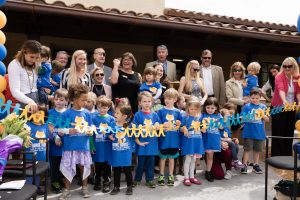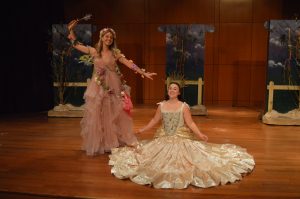
Just over a year after Rollins broke ground on the site, the new Child Development and Research Center (CDC), Hume House, was officially dedicated on March 6, 2017. This was a long-awaited day for many of the Psychology Department staff, including Professor Alice Davidson, who has been a part of the department for nine years. “I am so thrilled about the Hume House opening—we’ve worked so hard for this for so many years and in some ways, it’s hard to believe this day is finally here. I feel really proud of the building we helped create and, watching my Developmental Psychology students work on their observations in the new space over these past 2 weeks is exciting.” She has been with this project since the beginning; she said, “I was on the building planning committee that met regularly with the architects to help design a building that would be an optimal teaching, learning and research space for undergraduate students and for preschool children.”
For Dr. Sharon Carnahan, Executive Director of Hume House, the process has been even longer. “When I joined the faculty in 1990, the CDC was a 3 morning per week program for faculty and staff children, with a part time teacher who did not have a degree in the field. I cleaned the building myself at first, and my husband painted and fixed stuff. We dreamed of this larger facility, for the CDC to be seen as a laboratory, and built the program gradually over the years…. My first full proposal for funding was written in 1997!”
Before the new building, the CDC space was cramped, offering less students an area to study and interrupting the children more. There was also a larger need to use off-campus facilities, such as the Winter Park Day Nursery. The 5,050 square feet Hume House now offers many observation windows on three child classrooms, a research room, office space, and a classroom just for undergraduates. These changes have been essential to Rollins students’ learning. “…[W]e don’t have this sense of ‘get in and collect our data as fast as possible and then get out of there’ because it is so crowded and overwhelming to all,” explained Professor Davidson. The shift in students’ thinking has increased productivity, as well. “In these past 2 weeks, I’ve observed the students taking their work even more seriously, perhaps, because the building feels like a more ‘serious’ and important space for teaching and learning.”
“At the CDC, about 60% of the children belong to Rollins staff and faculty children, 20% are children of alumni, and 20% are from the Orlando community,” reported Dr. Carnahan. Professor Davidson’s daughter is one of the majority; she said she “cannot wait for her [daughter] to be involved in a number of studies at Hume House.” The program is also very inclusive to children with a wide range of disabilities, from sight and hearing impairments to autism. All students are tested around their birthdays to assess their progress. Parents participate in some surveys and studies, as well. With the new Hume House, there is plenty of room for all of these operations, as well as future plans for a new rFLA course and further community outreach and conferences.
Rollins’ own President was just as excited about the dedication ceremony to Rollins’ newest building. “We are pleased that our students and the children and families served by this program have an updated, spacious facility that will benefit the children who attend our center today and our future professionals of tomorrow,” remarked President Cornwell.
Overall, the dedication of this new facility will not only help students who will go into the field, but teach future parents lessons, too. “This new child development laboratory supports Rollins’ commitment to children and families, in addition to providing the highest quality of education for our undergraduate students who are the psychologists, teachers, behavior analysts, pediatricians, and parents of tomorrow,” stated Dr. Carnahan.










Be First to Comment